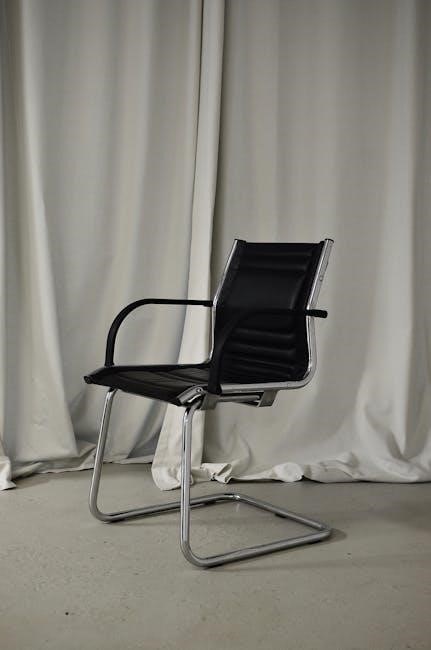Properly adjusting your office chair is crucial for comfort and health. This guide covers key features and adjustments to optimize ergonomics for all users, enhancing productivity and well-being.
1.1 Importance of Proper Chair Adjustment
Proper chair adjustment is essential for maintaining comfort, preventing health issues, and ensuring productivity. Incorrect settings can lead to discomfort, back pain, and long-term ergonomic problems. Adjusting your chair to fit your body promotes proper posture, reduces muscle strain, and supports overall well-being, making it a critical step for a healthy work environment.
1.2 Overview of Key Adjustable Features
Modern office chairs offer various adjustable features, including seat height, depth, lumbar support, armrests, tilt tension, and recline angle. These features ensure a personalized fit, promoting proper posture and comfort. Understanding and utilizing these adjustments is essential for creating an ergonomic and supportive workspace tailored to individual needs and preferences.
Adjusting the Seat Height
Adjust the seat height using the gas lift mechanism until your feet are flat on the floor and thighs are horizontal, ensuring proper posture and comfort.
2.1 How to Measure the Correct Seat Height
To measure the correct seat height, stand in front of the chair and adjust it until the highest point of the seat is just below your kneecap. This ensures your feet can rest flat on the floor with knees at a 90-degree angle, promoting proper posture and reducing leg strain.
2.2 Using the Gas Lift Mechanism
Sit down and pull the gas lift lever upward to release the mechanism. Slowly lower or raise the seat by applying gentle pressure. Stop when your feet are flat on the floor and knees are at a 90-degree angle. This feature allows easy customization of seat height for optimal ergonomics and comfort.
2.3 Ensuring Feet are Flat on the Floor
Keeping feet flat on the floor is essential for proper posture and comfort. Adjust the seat height so knees are at a 90-degree angle, preventing pressure on the back of the legs. If the floor is too far, consider using a footrest to maintain balance and avoid straining your lower back or neck.

Adjusting the Seat Depth
Proper seat depth ensures legs are supported without pressure behind the knees. Adjust the depth to leave 2-3 inches of space for optimal comfort and posture.
3.1 Measuring the Ideal Seat Depth
To determine the ideal seat depth, ensure there are 2-3 inches between the back of your knees and the chair’s edge. This prevents pressure on your legs, promoting proper blood flow and comfort. Adjust the seat depth so your thighs are fully supported without feeling cramped or restricted in any way.

3.2 Adjusting for Leg Clearance andComfort
Adjust the seat depth using the lever to leave about 2-3 inches between the back of your knees and the seat edge. This ensures no pressure on your legs, promoting proper blood flow. If the chair is too deep, consider using a footrest for added support and comfort, especially for shorter users.

Lumbar Support Adjustment
Proper lumbar support ensures your lower back curves naturally. Adjust the depth and height to fit your spine, promoting good posture and preventing strain during long hours.
4.1 Understanding the Lumbar Curve
The lumbar curve refers to the natural inward curve of the lower back. Proper office chair support aligns with this curve, ensuring spinal alignment and reducing strain. Adjusting the lumbar feature helps maintain this curve, promoting comfort and preventing long-term back issues. Correct alignment supports the body’s natural posture, enhancing overall well-being and productivity during work hours.
4.2 Adjusting the Lumbar Depth and Height
Adjust the lumbar support by moving it up or down to align with your natural curve. Use the adjustment mechanism to customize the depth, ensuring it gently presses into your lower back; Proper alignment supports posture, reduces strain, and enhances comfort. Experiment with settings to find the optimal position, ensuring it complements your body’s natural shape and promotes long-term back health.

Armrest Adjustment
Armrests should be adjusted to support elbows at 90 degrees, keeping wrists straight. Height and width adjustments ensure comfort and reduce strain on shoulders and neck muscles.
5.1 Adjusting Armrest Height
Adjust armrest height to align elbows at a 90-degree angle, wrists straight. Ensure armrests are level with desk height to avoid shoulder strain. Use levers or buttons to lower or raise them, promoting proper posture and comfort for extended periods of sitting.
5.2 Positioning Armrests for Elbow Support
Position armrests to provide optimal elbow support, keeping elbows slightly bent. Adjust width and height so arms rest gently, reducing strain on shoulders and neck. Proper positioning ensures even weight distribution, promoting comfort and preventing fatigue during long work hours.

Tilt and Recline Adjustment
Adjusting the tilt and recline features ensures proper posture and comfort. Modify the tilt tension to support your back and allow for comfortable movement while sitting.
6.1 Understanding Tilt Tension
Tilt tension controls the resistance of the chair’s backrest movement. Adjusting it allows customization of recline difficulty, ensuring support and comfort. A knob under the seat typically modifies this setting, enabling personalized ergonomics for optimal posture and relaxation during work.
6.2 Adjusting the Recline Angle
Adjusting the recline angle ensures proper spinal alignment and comfort. Sit with feet flat, knees at 90 degrees, and gently lean back. Use the tilt mechanism to set the desired angle, supporting your natural posture without straining. This promotes relaxation and reduces muscle fatigue during long working hours.
Maintenance and Care
Regular maintenance ensures longevity and comfort. Clean fabric or mesh with a damp cloth, vacuum, or mild soap. Lubricate moving parts with silicone spray. Inspect casters and mechanisms regularly to prevent wear and tear.
7.1 Cleaning the Chair Fabric or Mesh
Regularly clean the chair fabric or mesh to maintain hygiene and appearance. Use a soft, damp cloth to wipe down surfaces. For tougher stains, apply mild soap or upholstery cleaner. Avoid harsh chemicals or excessive water to prevent damage. Vacuum mesh panels gently to remove dust and debris. Ensure the chair is dry before use to prevent moisture buildup.
7.2 Lubricating Moving Parts
Lubricate moving parts like casters, hinges, and gas lifts to ensure smooth operation. Use a silicone-based spray to avoid attracting dust. Apply a small amount to each moving component, then wipe off excess with a cloth. Regular maintenance prevents squeaks and extends the chair’s lifespan. Avoid using oil or grease, as they may damage materials. Lubricate every 3-6 months for optimal performance.

Office Chair Instructions for Petite Users

Petite users often face challenges with standard chair sizes. This section provides tailored instructions to ensure proper adjustment for comfort and ergonomic support, addressing specific needs for shorter frames.
8.1 Adjusting for Shorter Body Frames
Petite users should lower the seat height so feet rest flat on the floor, ensuring knees are at or below hip level. Adjust the depth to prevent pressure behind the thighs. Use a footrest if necessary for optimal posture and circulation. These adjustments ensure comfort and alignment for shorter body frames, promoting ergonomic support and reducing strain.
8.2 Using Footrests for Added Support
Footrests are essential for petite users or those with shorter legs, ensuring feet remain flat and knees stay at a 90-degree angle. Position the footrest so your feet rest comfortably without strain. This enhances posture, reduces leg fatigue, and improves circulation. When using a footrest, ensure the seat height still allows a small gap between the chair and the back of your knees for optimal comfort and blood flow.

Encouraging Movement and Ergonomic Habits
Regular movement and ergonomic habits are vital for long-term comfort. Stand or stretch every 30 minutes and adjust your chair to promote proper posture and circulation.
9.1 Importance of Regular Movement
Regular movement is essential to maintain comfort and health while using an office chair. Sitting for long periods can lead to stiffness and poor circulation. Encourage stretching, walking, or changing positions every 30 minutes to refresh the body and mind. This practice helps prevent fatigue and supports overall well-being, even with a perfectly adjusted chair.
9.2 Setting Reminders to Adjust Positions
Setting reminders to adjust your chair position ensures consistent comfort and proper ergonomics. Use digital calendars, apps, or sticky notes to remind yourself to move every 30 minutes. This habit prevents prolonged sitting, reduces fatigue, and helps maintain optimal posture, promoting long-term health and productivity in the workplace.
Troubleshooting Common Issues
Address common problems like a chair not staying at the right height or a malfunctioning tilt mechanism by checking the gas lift and tightening loose parts promptly.
10.1 Fixing a Chair That Won’t Stay at the Right Height
If your chair isn’t maintaining its height, inspect the gas lift for damage or wear. Ensure the chair is on a level surface and check for obstructions. Tighten any loose parts, especially around the gas cylinder. If issues persist, consider replacing the gas lift mechanism or consulting a professional for assistance.
10.2 Resolving Tilt Mechanism Problems
If your chair’s tilt mechanism isn’t functioning properly, start by checking the tilt tension knob. Adjust it to suit your weight and preferred resistance. Ensure the mechanism is free from debris and lubricate moving parts if necessary. If issues persist, refer to the chair’s manual or contact a professional for further assistance to restore smooth functionality.
Advanced Features and Customization
Customize your chair with adjustable backrest angles, lumbar depth, and arm caps for enhanced support. Explore these features to tailor your chair to your ergonomic needs perfectly.
11.1 Adjusting the Backrest Angle
Adjusting the backrest angle ensures proper spinal alignment and support. To modify it, locate the mechanism, typically a knob or lever, and tilt the backrest to fit your posture. For optimal comfort, align it so your upper back is flush with the chair, promoting natural lumbar curvature and reducing strain during long hours of work.
11.2 Using Adjustable Arm Caps
Adjustable arm caps enhance comfort by allowing customization of height, swivel, and width. To use them effectively, lower the armrests to support elbows at a 90-degree angle, ensuring wrists remain straight. Swivel the caps to align with your arms during tasks like typing or using the mouse. Adjust the width to fit your body and consider padding for comfort. Regularly check and modify these settings to maintain proper posture and prevent discomfort or strain. Proper armrest adjustment is crucial for long-term ergonomic support and overall well-being while working.

Case Studies and Success Stories
Studies show proper chair adjustment boosts productivity and reduces discomfort. For example, users of Herman Miller Mirra 2 reported improved posture and pain reduction after ergonomic customization.
12.1 How Proper Adjustment Improved Productivity
By optimizing chair settings, employees experienced enhanced comfort, leading to increased focus and efficiency. Many reported a 15-20% productivity boost due to better posture and reduced fatigue, emphasizing the importance of ergonomic adjustments in workplace environments to foster overall well-being and performance.
12.2 Real-Life Examples of Ergonomic Benefits
Employees who adjusted their chairs reported reduced back pain, improved posture, and enhanced comfort, resulting in fewer sick days and higher job satisfaction. A study showed that ergonomic chair adjustments led to a 30% decrease in workplace injuries, proving that proper setup directly contributes to long-term health and productivity benefits for users.
Proper office chair adjustment promotes better posture, reduces discomfort, and boosts productivity. Consistently applying these ergonomic tips ensures long-term comfort and overall well-being for users of all sizes.
13.1 Summarizing Key Takeaways
Proper office chair adjustment is essential for ergonomics and comfort. Key takeaways include optimizing seat height, lumbar support, and armrest positioning. Regular movement and maintenance, like cleaning and lubricating parts, are vital. Petite users may need footrests, while others benefit from tilt and recline adjustments. These strategies enhance productivity, reduce discomfort, and promote long-term well-being for all users.
13.2 Final Tips for Long-Term Comfort
Regularly clean and maintain your chair to ensure functionality. Adjust settings to suit your posture and tasks. Take breaks to move and stretch, promoting circulation and energy. Personalize ergonomics for your body type and work style. Prioritize comfort and support to enhance productivity and overall well-being over time.
